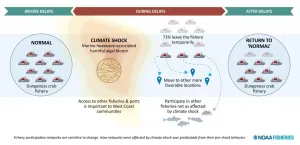(Press-News.org) BUFFALO, N.Y. - The human body is filled with friendly bacteria. However, some of these microorganisms, such as Veillonella parvula, may be too nice. These peaceful bacteria engage in a one-sided relationship with pathogen Porphyromonas gingivalis, helping the germ multiply and cause gum disease, according to a new University at Buffalo-led study.
The research sought to understand how P. gingivalis colonizes the mouth. The pathogen is unable to produce its own growth molecules until it achieves a large population in the oral microbiome (the community of microorganisms that live on and inside the body).
The answer: It borrows growth molecules from V. parvula, a common yet harmless bacteria in the mouth whose growth is not population dependent.
In a healthy mouth, P. gingivalis makes up a miniscule amount of the bacteria in the oral microbiome and cannot replicate. But if dental plaque is allowed to grow unchecked due to poor oral hygiene, V. parvula will multiply and eventually produce enough growth molecules to also spur the reproduction of P. gingivalis.
More than 47% of adults 30 and older have some form of periodontitis (also known as gum disease), according to the Centers for Disease Control and Prevention. Understanding the relationship between P. gingivalis and V. parvula will help researchers create targeted therapies for periodontitis, says Patricia Diaz, DDS, PhD, lead investigator on the study and Professor of Empire Innovation in the UB School of Dental Medicine.
"Having worked with P. gingivalis for nearly two decades, we knew it needed a large population size to grow, but the specific processes that drive this phenomenon were not completely understood," says Diaz, also director of the UB Microbiome Center. "Successfully targeting the accessory pathogen V. parvula should prevent P. gingivalis from expanding within the oral microbial community to pathogenic levels."
The study, which was published on Dec. 28 in the ISME Journal, tested the effects of growth molecules exuded by microorganisms in the mouth on P. gingivalis, including molecules from five species of bacteria that are prevalent in gingivitis, a condition that precedes periodontitis.
Of the bacteria examined, only growth molecules secreted by V. parvula enabled the replication of P. gingivalis, regardless of the strain of either microbe. When V. parvula was removed from the microbiome, growth of P. gingivalis halted. However, the mere presence of any V. parvula was not enough to stimulate P. gingivalis, as the pathogen was only incited by a large population of V. parvula.
Data suggest that the relationship is one-directional as V. parvula received no obvious benefit from sharing its growth molecules, says Diaz.
"P. gingivalis and V. parvula interact at many levels, but the beneficiary is P. gingivalis," says Diaz, noting that V. parvula also produces heme, which is the preferred iron source for P. gingivalis.
"This relationship that allows growth of P. gingivalis was not only confirmed in a preclinical model of periodontitis, but also, in the presence of V. parvula, P. gingivalis could amplify periodontal bone loss, which is the hallmark of the disease," says George Hajishengallis, DDS, PhD, co-investigator on the study and Thomas W. Evans Centennial Professor in the University of Pennsylvania School of Dental Medicine.
"It is not clear whether the growth-promoting cues produced by P. gingivalis and V. parvula are chemically identical," says Diaz. "Far more work is needed to uncover the identity of these molecules."
INFORMATION:
Additional investigators include Anilei Hoare, PhD, assistant professor, University of Chile; Hui Wang, PhD, postdoctoral researcher, University of Pennsylvania; Archana Meethil, resident, University of Connecticut; Loreto Abusleme, PhD, assistant professor, University of Chile; Bo-Young Hong, PhD, associate research scientist, Jackson Laboratory for Genomic Medicine; Niki Moutsopoulos, DDS, PhD, senior investigator, National Institute of Dental and Craniofacial Research; and Philip Marsh, PhD, professor, University of Leeds.
The research was funded by the National Institute of Dental and Craniofacial Research of the National Institutes of Health.
The human papillomavirus infection, or HPV, is the most common sexually transmitted infection in the U.S., according to the Centers for Disease Control and Prevention. HPV is associated with health problems including genital warts and cancers, but a vaccine has been available since 2006 to help stop the virus. The CDC reports more than 12 years of data supports the HPV vaccine is safe and effective, yet HPV vaccination rates across the U.S. still remain low.
Social media has a history of being a popular place for sexual health discussions, and the HPV vaccine is one of the most discussed vaccines on the internet. Monique Luisi, an assistant professor in the University of Missouri School of Journalism, has studied more than 6,500 public HPV vaccine-related posts ...
While humanity is facing the COVID-19 pandemic, the citrus industry is trying to manage its own devastating disease, Huanglongbing (HLB), also known as citrus greening disease. HLB is the most destructive citrus disease in the world. In the past decade, the disease has annihilated the Florida citrus industry, reducing orange production for juice and other products by 72%. Candidatus Liberibacter asiaticus (CLas) is the microbe associated with the disease. It resides in the phloem of the tree and, like many plant pathogens, is transmitted by insects during feeding events. Disease progression can be slow but catastrophic. Symptoms begin with blotchy leaves, yellow shoots, and stunting, ...
BOSTON -- Getting control of COVID-19 will take more than widespread vaccination; it will also require better understanding of why the disease causes no apparent symptoms in some people but leads to rapid multi-organ failure and death in others, as well as better insight into what treatments work best and for which patients.
To meet this unprecedented challenge, researchers at Massachusetts General Hospital (MGH), in collaboration with investigators from Brigham and Women's Hospital and the University of Cyprus, have created a mathematical model based on biology that incorporates information ...
Diabetes continues to be the leading cause of new cases of blindness among adults in the United States. But the current shortage of eye-care providers would make it impossible to keep up with demand to provide the requisite annual screenings for this population. A new study looks at the effectiveness of seven artificial intelligence-based screening algorithms to diagnose diabetic retinopathy, the most common diabetic eye disease leading to vision loss.
In a paper published Jan. 5 in Diabetes Care, researchers compared the algorithms against the diagnostic expertise of retina specialists. Five companies produced the tested algorithms - two in the United States (Eyenuk, Retina-AI Health), one in China (Airdoc), one in Portugal (Retmarker), ...
Fishermen contend with regulations, natural disasters, and the ups and downs of the stocks they fish, along with many other changes. As a result, fishing communities are quite resilient. That is, they can withstand, recover from, and adapt to change.
But how much pressure can they stand? The 2014-2016 North Pacific marine heatwave, known as the Blob, led to a harmful algal bloom of unprecedented scale. It necessitated substantial delays in the opening of the 2015-16 U.S. West Coast Dungeness crab fishery. The fishery is vital to West Coast communities. It produces around 26 percent of all annual fishing revenue and supports more than 30 percent of all commercial fishing vessels.
Understanding ...
Humans have consumed different types of fermented foods - from kimchi to yogurt - for thousands of years. Yet only recently, with the availability of new scientific techniques for analyzing their nutritional properties and microbiological composition, have scientists begun to understand exactly how the unique flavors and textures are created and how these foods benefit human health.
Now, 13 interdisciplinary scientists from the fields of microbiology, food science and technology, family medicine, ecology, immunology, and microbial genetics have come together to create the first international consensus definition of fermented ...
Hotel managers have something in common beyond their reputations for charming dispositions and excellent listening skills - they're predominantly men, despite women making up the majority of the accommodations workforce. New research led by the University of Houston Conrad N. Hilton College of Hotel and Restaurant Management suggests hotel companies that promote a woman over an equally qualified man are perceived as fairer and less discriminatory, creating a stronger organizational culture and higher financial performance.
Published in the International Journal of Contemporary Hospitality Management, the study is the first to address gender inequity in promotional opportunities for hotel employees. The researchers surveyed 87 hotel ...
DENVER/January 5, 2020 - Some English bulldogs diagnosed with a common cancer may instead have a newly described, non-cancerous syndrome called polyclonal B‐cell lymphocytosis. The discovery was made by Morris Animal Foundation-funded researchers at Colorado State University during a study to better understand B-cell chronic lymphocytic leukemia (BCLL). The team published their findings in the Journal of Veterinary Internal Medicine.
"This could save some dogs from being misdiagnosed, treated for cancer or even euthanized when they shouldn't be," said Dr. Anne Avery, Professor, Department of Microbiology, Immunology and Pathology at Colorado State University. "The dogs may look to their veterinarians like they ...
BOSTON - (January 4, 2021) - As they age, people with diabetes are more likely to develop Alzheimer's disease and other cognitive disorders than are people without diabetes. Scientists at Joslin Diabetes Center now have shown that routine eye imaging can identify changes in the retina that may be associated with cognitive disorders in older people with type 1 diabetes.
These results may open up a relatively easy method for early detection of cognitive decline in this population, providing better ways to understand, diagnose and ultimately treat the decline, said George L. King, MD, Joslin's Chief Scientific Officer and senior author on a paper about the study in the Journal of Clinical Endocrinology & Metabolism.
Previous research had demonstrated an association ...
To stop biodiversity loss, Canada recently committed to protecting 30% of its land and sea by 2030. But making conservation decisions about where to locate new protected areas is complicated. It depends on data both about biodiversity and about a range of benefits (e.g. freshwater, climate regulation, recreation) that people get from nature. Surprisingly, despite the size of the country, new mapping suggests that less than 1% of Canada's land (0.6% of total area or approximately 56,000 km2) is a hot spot, providing all these benefits in one place. Moreover, the study published today in Environmental Research Letters suggests that some of the most critical areas where people receive these key benefits from ...






